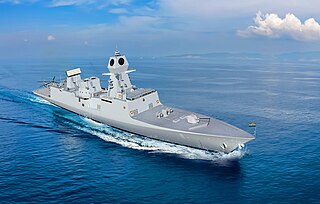
The Indian Navy is the maritime branch of the Indian Armed Forces. The President of India is the Supreme Commander of the Indian Navy. The Chief of Naval Staff, a four-star admiral, commands the navy. As a blue-water navy, it operates significantly in the Persian Gulf Region, the Horn of Africa, the Strait of Malacca, and routinely conducts anti-piracy operations and partners with other navies in the region. It also conducts routine two to three month-long deployments in the South and East China seas as well as in the western Mediterranean sea simultaneously.

Sindhughosh-class submarines are Kilo-class diesel-electric submarines in active service with the Indian Navy. Their names are in Sanskrit, but in their Roman-alphabet forms sometimes a final short -a is dropped.
The Arihant-class is a class of Indian nuclear ballistic missile submarines under construction for the Indian Navy. They were developed under the ₹900 billion (US$11 billion) Advanced Technology Vessel (ATV) project to design and build nuclear-powered submarines. These vessels are classified as 'strategic strike nuclear submarines' by India.

INS Arihant, designated S2 Strategic Strike Nuclear Submarine, is the lead ship of India's Arihant class of nuclear-powered ballistic missile submarines. The 6,000 tonne vessel was built under the Advanced Technology Vessel (ATV) project at the Ship Building Centre in the port city of Visakhapatnam.

The Nilgiri-class frigates, formally classified as the Project-17 Alpha frigates (P-17A), are a series of stealth guided-missile frigates currently being built by Mazagon Dock Shipbuilders (MDL) and Garden Reach Shipbuilders & Engineers (GRSE) for the Indian Navy (IN).

The Kalvari-class submarines, formally classified as the Project-75 submarines (P-75), is a class of diesel-electric attack submarines operated by the Indian Navy. Currently being constructed by a syndicate of French and Indian shipyards, namely, Naval Group and Mazagon Dock Limited (MDL) respectively, the class is an export derivative of the French-origin Scorpène-class submarine, originally designed by Naval Group.
The Kattupalli Shipyard, officially Adani Katupalli Port Private Limited, is a large shipyard project at Kattupalli village near Ennore in Chennai, being built by L&T Shipbuilding Ltd. It is being set up jointly by TIDCO and Larsen & Toubro (L&T) in two phases. L&T shipbuilding Kattupalli is a minor port. Adani ports and special economic zone (APSEZ) acquired Kattupalli Port from L&T in June 2018 and renamed it as Adani Katupalli Port Private Limited (AKPPL).
INS Vishal, also known as Indigenous Aircraft Carrier 3 (IAC-3), is a planned aircraft carrier to be built by Cochin Shipyard Limited for the Indian Navy. It is intended to be the third aircraft carrier to be built in India after INS Vikrant (IAC-1) and another Vikrant-class aircraft carrier, provisionally called (IAC-2). The proposed design of this class will be a new design, featuring significant changes from Vikrant, including an increase in size and displacement. An Electromagnetic Aircraft Launch System (EMALS) CATOBAR system is also under consideration. Its name Vishal means 'Gargantuan' in Sanskrit.
K-4 or Kalam-4 is a nuclear capable intermediate-range submarine-launched ballistic missile developed by the Defence Research and Development Organisation of India to arm its Arihant-class submarines. The missile has a maximum range of about 4000 km which offers greater operational flexibility compared to its predecessor K-15 having a limited shore-bounding range. On deployment, the missile will be the first to operationalise India's sea-based nuclear triad and can accommodate the demand of credible second-strike capability of its nuclear doctrine.

INS Varsha is a new naval base being developed under Project Varsha for the Indian Navy. This base will be the home of the navy's new fleet of nuclear submarines and ships. It was planned to be located within a radius of approximately 200 kilometres from Visakhapatnam, the headquarters of the navy's Eastern Naval Command. Previous news reports suggested that Gangavaram had been the initial site for the new base. The base is now being developed at Rambilli, which is 50 km from Visakhapatnam.

INS Arighaat is an upgraded variant of the Arihant-class submarine. It is the second nuclear-powered ballistic missile submarine made by India under the Advanced Technology Vessel (ATV) project to build nuclear submarines at the Ship Building Centre in Visakhapatnam. It has the code name S3.

The Anti-Submarine Warfare Shallow Water Craft (ASW-SWC) corvettes, are a class of anti-submarine warfare (ASW) vessels currently being built for the Indian Navy, by Cochin Shipyard (CSL) and Garden Reach Shipbuilders & Engineers (GRSE). They were conceived as a replacement to the ageing Abhay-class corvettes of the Indian Navy, and are designed to undertake ASW duties – including subsurface surveillance in littoral waters, search-and-attack unit (SAU) missions and coordinated anti-submarine warfare operations with naval aircraft. They were also designed to provide secondary duties – including defense against intruding aircraft, minelaying and search-and-rescue (SAR).

INS Kattabomman is the designation of the VLF-transmission facility of the Indian Navy situated at Vijayanarayanam near Tirunelveli in Tamil Nadu. The facility spread over 3,000 acres has 13 masts, which are arranged in two rings around the central mast. The centre mast has a height of 301 metres, the masts on the inner ring measure 276.4 metres, that on the outer ring measure 227.4 metres.

The Indian Navy has been focusing on developing indigenous platforms, systems, sensors and weapons as part of the nation's modernisation and expansion of its maritime forces. As of November 2023, the Indian Navy had 67 vessels of various types under construction including destroyers, frigates, corvettes, conventional-powered and nuclear-powered submarines and various other ships. It plans to build up to a total of 200 vessels and 500 aircraft by 2050. According to the Chief of the Naval Staff's statement in December 2020, India has transformed from a buyer's navy to a builder's navy.

The Visakhapatnam-class destroyers, also classified as the P-15 Bravo class, or simply P-15B, is a class of guided-missile destroyers currently being built for the Indian Navy. The Visakhapatnam class is an upgraded derivative of its predecessor, the Kolkata class, with improved features of stealth, automation and ordnance.

Project-75 (India), simply referred to as the P-75(I) program, is a military acquisition initiative affiliated to India's Ministry of Defence (MoD), aimed at the planned procurement of diesel-electric submarines for the Indian Navy (IN). Originally conceived in 1997, the initiative's objective has been to procure a class of six conventionally-powered attack submarines for the Indian Navy Submarine Arm, as a replacement for the force's Sindhughosh-class submarines.

S5 is the code name for a planned class of Indian nuclear-powered ballistic missile submarines currently being developed for the Indian Navy. S5 will weigh around twice as much as the preceding Arihant-class submarine. It is expected to start production by 2027.

The HSL-class fleet support vessels are a series of five fleet tanker planned to be built by Hindustan Shipyard (HSL), Visakhapatnam and Larsen & Toubro at Kattupalli Shipyard for the Indian Navy. The deal was signed on 25 August 2023 with an expected project completion timeline of 8 years. These ships will be an indigenous design by the Hindustan Shipyard's in-house design team. The primary role of the vessels would be to replenish ships of the Indian Navy with fuel, food and various other supplies. With a length of 230 m and displacement of 45,000 tonnes, these will be the heaviest and the second largest vessels to be in operation in the Indian Navy fleets before 2030.

The Project-17 Bravo frigates (P-17B) or Next Generation Frigates (NGF) are a class of planned stealth guided-missile frigates to be built for the Indian Navy (IN). The class will be a follow-on for Nilgiri-class frigates which is under construction. The class is a part of Next Generation series of future frontline surface combatants of the Indian Navy which includes Next Generation Destroyers (NGD) or Project 18-class destroyer and Next Generation Corvettes (NGC).













